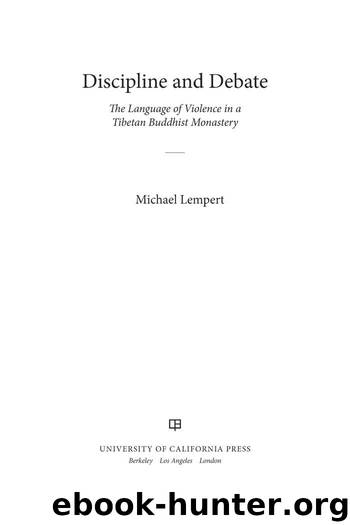Discipline and Debate: The Language of Violence in a Tibetan Buddhist Monastery by Lempert Michael

Author:Lempert, Michael [Lempert, Michael]
Language: eng
Format: azw3
ISBN: 9780520952010
Publisher: University of California Press
Published: 2012-03-30T16:00:00+00:00
When someone creates a small infraction of the rules of this great and precious college, if such a person is sitting at the head of the row one should look toward the back of it, and if he is sitting toward the east then one should look toward the west. In other words, one should offer [the exhortation] so that others are not aware [of the identity of the perpetrator of the offense], even though one is oneself aware. If that individual does not recognize that [the advice] is being directed at him, then during the second exhortation it is necessary to make others slightly aware [of the identity of the person] by referring oneself to those who sit near him in the row and to his housemates. If the individual still does not recognize that it is being directed at him, then on the third occasion one must direct oneself at the very person and say, “You have broken such and such a rule,” offering [the exhortation] by pointing the finger at him. (Cabezón 1997: 342–43)9
This indirection plays a role in communicating the disciplinarian’s histrionic anger, I will suggest, though this does not exhaust its significance. This indirection also has the virtue of “lateral effects”: it speaks to all because it is addressed to no one. It enhances the scope of the disciplinarian’s address, “generalizing” his censure into a moral palliative for the whole monastic community. In this, it is akin to the piercing echoes of the leather strap with which the disciplinarian’s assistant metes out mild corporal punishment in public assemblies. That is, there is a certain infectious paranoia that the disciplinarian’s low-resolution sketches of social types can induce; with enough scrutiny, you begin to wonder, Is he talking about me? You recognize yourself in these nebulous portraits. Second, this indirect addressivity lends to the disciplinarian the impression of an almost preternatural capacity for surveillance, for if the disciplinarian can get the guilty monk to feel that he has been discovered, he can only be impressed by this feat, which bolsters the disciplinarian’s authority. And without indexically pinning infractions to real people—to biographically individuated souls—it also means that the indictments, and by extension the disciplinarian, can never be wrong. Together, all these facts conspire to figurate the disciplinarian’s own omniscience, or at least omnipresence (How could he know this? Maybe he really can channel the college’s protector deity. Did his assistant spot me, or someone report me?)
Geshe-la needed an agent. He needed the stealth and industry of his assistant to monitor and collect information on Mey monks. The assistant, Jermey, a sturdy twenty-four-year-old monk, did not welcome this job. At nineteen he braved the overland trek from Tibet to Nepal, two days of which were spent trundling forward with a young child slung over his back. To see he had to literally pry his eyes open with his hands. He saw people slip and fall to their deaths and others succumb to frostbite. Were he to face this journey again, he’d prefer a pistol to his temple, he swore.
Download
This site does not store any files on its server. We only index and link to content provided by other sites. Please contact the content providers to delete copyright contents if any and email us, we'll remove relevant links or contents immediately.
Cecilia; Or, Memoirs of an Heiress — Volume 1 by Fanny Burney(32433)
Cecilia; Or, Memoirs of an Heiress — Volume 2 by Fanny Burney(31866)
Cecilia; Or, Memoirs of an Heiress — Volume 3 by Fanny Burney(31850)
The Lost Art of Listening by Michael P. Nichols(7403)
Asking the Right Questions: A Guide to Critical Thinking by M. Neil Browne & Stuart M. Keeley(5629)
We Need to Talk by Celeste Headlee(5542)
On Writing A Memoir of the Craft by Stephen King(4863)
Dialogue by Robert McKee(4321)
Pre-Suasion: A Revolutionary Way to Influence and Persuade by Robert Cialdini(4142)
I Have Something to Say: Mastering the Art of Public Speaking in an Age of Disconnection by John Bowe(3838)
Elements of Style 2017 by Richard De A'Morelli(3306)
The Book of Human Emotions by Tiffany Watt Smith(3236)
Fluent Forever: How to Learn Any Language Fast and Never Forget It by Gabriel Wyner(3024)
Name Book, The: Over 10,000 Names--Their Meanings, Origins, and Spiritual Significance by Astoria Dorothy(2938)
Good Humor, Bad Taste: A Sociology of the Joke by Kuipers Giselinde(2902)
Why I Write by George Orwell(2874)
The Art Of Deception by Kevin Mitnick(2735)
The Grammaring Guide to English Grammar with Exercises by Péter Simon(2706)
Ancient Worlds by Michael Scott(2622)
